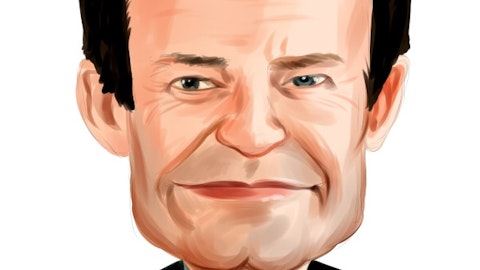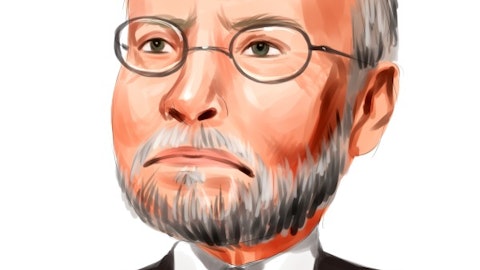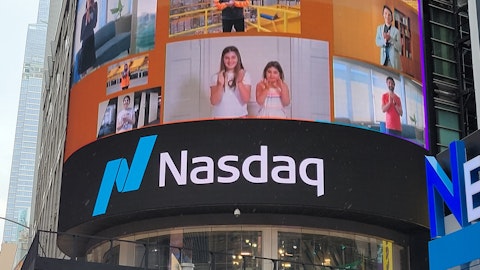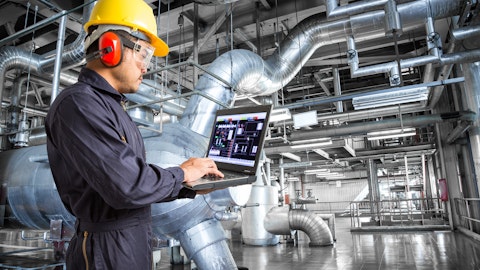Michael Dudas: Bill, can you just share some thoughts since you were promoted to the Chief Operating Officer earlier this year. I guess maybe six to seven months in that job and what did you find out after moving from the finance chair about the company and I’m assuming some of these implementations were your ideas. And then how you could translate that as CEO to allow Alcoa to capture more of the anticipated cost reductions and likely and hopefully pricing improvements that should run through the business in a more normalized environment over the next couple of years.
William Oplinger: So what I found out when I transitioned from a long stint as the CFO, 10 years as the CFO into what turned out to be a short stint in the COO role was a couple of things. First of all, I was happy to find that we have great people in operations. We have people who have long tenure, you know, 20, 30 years with the company that have tremendous institutional knowledge. But we’ve also brought in a lot of newer people who see things in new ways, and do things new ways. So I was really pleased to get to see that. And just as an aside, loved my COO role for eight months. The other thing that I learned there was a tremendous amount of opportunity out there and people were really wanting to do things differently, wanting to aggressively address some things and so I thought there was tremendous amount of opportunity.
So if I transition to some thoughts around the CEO role just to be clear, and I’m sure this question may be was embedded in your original question or will be asked later on, the strategy and direction of the company is largely unchanged. We know where we’re going from a strategic perspective. The thing that I’m trying to drive as CEO and you see this changing over the last year or so is really a cultural change that cultural change is making decisions at a faster pace. It’s having a performance orientation in everything we do. And really an expectation of excellence in everything we do and I hit upon this in my prepared remarks, whether it’s operations maintenance, finance, an expectation of really being excellent. If we then couple that with what I think are the inherent advantages of Alcoa, so some of the inherent advantages of our company.
We are present in all aspects of the value chain. We’re a pure-play aluminum company. We’re not spending time on other parts of battery minerals, we are focused exclusively on being successful in Aluminum. We have a global presence and back to that first part of the question, I think we have unmatched technical expertise still in this company. We haven’t really shown it in the last couple of years on the operations side. But I think it’s there and we’re starting to show it now. So when I combine all of that, I translate that into an ambition for the company that we want to re-establish ourselves as the premier aluminum company in the world. And I think we can do that and not to go on too long, Michael. I’m really excited and I’m really happy to be in the role that I am in.
Michael Dudas: Appreciate those observations. Looking out how quickly do you think you can implement the culture and, you know, kind of get best practices throughout the organization and productivity enhancements to show meaningful results or achieve those goals. Is it a three months, six months a year, is it something that can — how urgent do you see that process even though the overall strategy has not changed?
William Oplinger: Right, so Rome wasn’t built in a day. We’re not going to change the culture of this company in a day or a week or a quarter. However, look at the bridge that Molly showed, we saw production cost improvements for the first time in a long time in the third quarter and just so you understand how that bridge works, that’s largely because we were able to make the tons. And so we were able to make the tons in the third quarter and the guidance that she gave was a pretty strong guidance with the exception of the carbon change from the Norwegian government which is totally outside of our control. So I think we’re seeing some of that change today already and I think you’ll see more in the future and everybody I talk to within Alcoa, hears the story of performance culture.
We’re trying to drive a performance culture and it’s all about having expectations of excellence and driving those expectations of excellence and I think we’ve seen that on the upside to some extent. We’ve set records in Quebec. We’re getting better stability in places like Brazil and the restart, much significantly better stability, and operational performance in our Western Australia assets, even though they have worse bauxite quality. So I think we’re seeing it now and hopefully accelerate into the future.
Michael Dudas: Excellent, Bill. Thank you.
Operator: The next question is from Bill Peterson with JPMorgan. Please go ahead.
Bill Peterson: Yeah, hi, good afternoon, thanks for taking the questions and, you know, Bill, good luck in the new role.
William Oplinger: Thanks, Bill.
Bill Peterson: So I wanted to take a step back to maybe more macro supply demand. So you just said you mentioned at LME. I guess what’s the latest you’ve seen in terms of supply demand balance, I guess in the context of restarts in Yunnan, you know, relatively weak, you know, macro backdrop. And then I guess maybe on the end market demand side, where are you seeing most resilience and then what remains most muted and any sort of color between regions?
William Oplinger: So, 2023 is going to go down as a pretty tough year for the aluminum industry. In 2023, we see a slight surplus on the aluminum side. On Alumina it’s fairly balanced and so, you know, on the aluminum side, we see about an 800,000 ton surplus in 2023. The reason for that is demand in rest of world — rest of world actually contracted in 2023. So some of the big demand drivers in the rest of world that we’ve seen this year are really a reduction — significant reduction in building and construction, actually a reduction of demand in packaging of all places, ever so slight and so across the board, we’re seeing some weakness in the end markets. Now, you referenced my trip to the LME where pretty resoundingly what we hear amongst all the industry players is that 2023 and maybe going into 2024 can still be difficult times for aluminum, but it’s just a matter of time where aluminum has a significantly better market environment.
The reason why we see that as that demand continues to grow, starting to see even in 2024, a rebound in places like building and construction, some of the destocking that we saw occur in can sheet is now over. So, we should see a rebound in demand there. And we fundamentally believe that the Chinese cap on supply will be maintained at the 45 million metric tons, and we can address why we believe that. But over time, we see that the market fundamentals for the metal itself are really driven by some of the macro trends over the longer period of time with the EVs and solar, should be significantly better than they are today. But with that said, it’s been a pretty tough year on demand in aluminum.
Bill Peterson: That’s great color. I may have missed it, but I believe last quarter you — there was an update about San Ciprian discussing the planned phase restart to start at the beginning of 2024 with full restart by October ’25. And then we’re obviously trying to basically capture and set the PPA’s in motion. But can you give us an update there, again, I may have missed it, but I didn’t see that in the prepared remarks.





